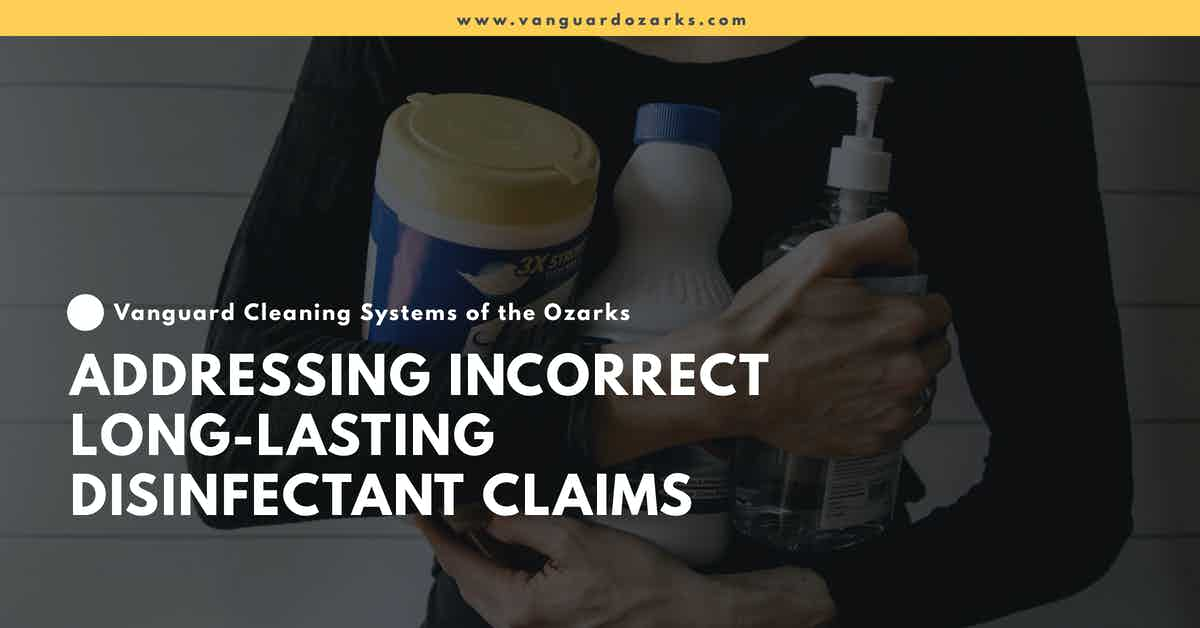The ongoing COVID-19 public health emergency has led to an unfortunate combination of incorrect assumptions made by well-intentioned facility managers and service providers, and false statements made by unscrupulous disinfectant manufacturers, regarding the proven residual efficacy of disinfectants against viruses.
The Residual Efficacy of Surface Disinfectants Against Viruses, Bacteria, Mildew, and Fungi
How long does a disinfectant product protect a surface from viruses once it is applied?
Until the surface is recontaminated with another pathogen.
In other words, almost immediately upon human re-entry.
The purpose of disinfectants, in regards to viral pathogens, is to kill viruses on surfaces and maintain their detectable level below that which could likely infect a healthy human, or, in the case of long-term care facilities, hospitals, and surgery centers, below the level that could harm an occupant with a compromised immune system.
However, you or someone you know has likely encountered long-term surface protection claims made by disinfectant manufacturers.
Those claims, where validated by the U.S. Environmental Protection Agency (EPA), are true.
However, they are only valid for bacteria and fungi, not viruses.
According to the EPA;
EPA regulates the claims on pesticide product labels.
EPA-registered surface disinfectants kill viruses at the time they are used.
After use, if new viral particles come into contact with the surface, a previously applied disinfectant will not protect against these new particles.
EPA has not evaluated the efficacy of any products claiming long-lasting efficacy against viruses.
Therefore, there are no EPA-registered products with label claims that they are effective against viruses over the course of hours to months (i.e., “residual” or “long-lasting” efficacy claims).
There are some antimicrobial pesticides that EPA calls materials preservatives that can be incorporated into articles.
Known as “treated articles,” these plastics, textiles, or other materials are treated with or contain a materials preservative to protect the article itself from mold or bacteria that can cause odor, discoloration, or deterioration.
Is there anything I can do to make surfaces resistant to SARS-CoV-2 (COVID-19)
Currently, the EPA recognizes three claims of residual efficacy regarding surface sanitizers and disinfectants.
- Bacteriostatic, mildewstatic, or fungistatic - A non-public health claim regarding the product's ability to inhibit the growth of bacteria, mildew, and fungi on surfaces, but does not necessarily kill them.
- Residual sanitation - A public health claim regarding a product's ability to kill 99.9% of bacteria on surfaces for up to 24 hours, and;
- Residual disinfection - A public health claim regarding a product's ability to disinfect a surface for up to 24 hours.
In light of the ongoing SARS-CoV-2 public health emergency, the EPA is evaluating disinfectant product claims of residual efficacy against viruses.
However, its current position is;
Recognizing a real need for more information to reduce potential exposure to SARS-CoV-2 on these kinds of surfaces, researchers are evaluating a number of commercially available products for potential long-lasting effectiveness against the virus.
Currently, EPA-registered products with long-lasting effectiveness claims are limited to those that control odor-causing bacteria on hard, non-porous surfaces; there are no EPA registered products with public health claims that provide long-lasting (e.g., weeks to months) disinfection.
The benefits of having a longer-lasting antimicrobial product are important, especially when cleaning and disinfecting a surface or object cannot be accomplished every time someone new touches it.
Addressing Surface Sanitation for Healthy Facilities
In lieu of any verifiable claims regarding the long-term efficacy of surface disinfectants against viruses, a well-designed and rigorously practiced cleaning and disinfection plan is necessary.
Given the differences in facility occupancy and use, occupant health and safety requirements, and organizational budgeting and available resources, the 'best' path towards a safe and hygienic facility will vary greatly from one building, business, or school to another.
However, certain principles and practices have proven highly effective against influenza and SARS, regardless of facility size or type, including:
- Clean for health first using regular soap-based detergents and microfiber tools.
- Establish cleaning zones and checklists to prevent surface cross-contamination and ensure all areas of a room or facility are correctly attended to, and that any changes to a cleaning plan are easily communicated, and;
- Identify high-touch surfaces throughout each zone and document them, then assign a porter to disinfect those surfaces with an EPA approved (List N) disinfectant throughout the day.
References & Resources
Takeaway
Unfortunately, there is no clear and easy path through the ongoing challenges of safe and effective surface disinfection.
Not for COVID, Influenza, or any other pathogen.
However, an effective cleaning plan combined with state of the art tools and advanced service provider training can be highly effective.
Outsourcing your facilities' cleaning and infection prevention and control measures to an experienced service provider is a proven method for ensuring the highest standards of cleanliness and safety are adhered to.
Contact us today and discover why Vanguard Cleaning Systems® is the Standard of Clean® for businesses throughout Northwest Arkansas, Missouri, and Oklahoma.
In Oklahoma, dial 918-960-4450
In Arkansas, dial 479-717-2410
In Missouri, dial 417-812-9777

